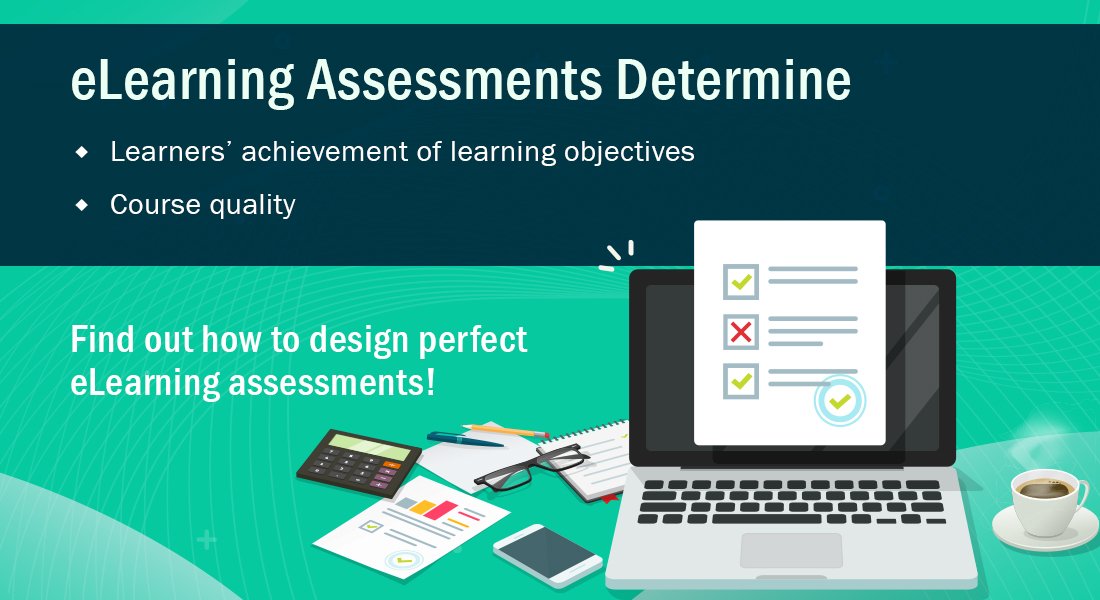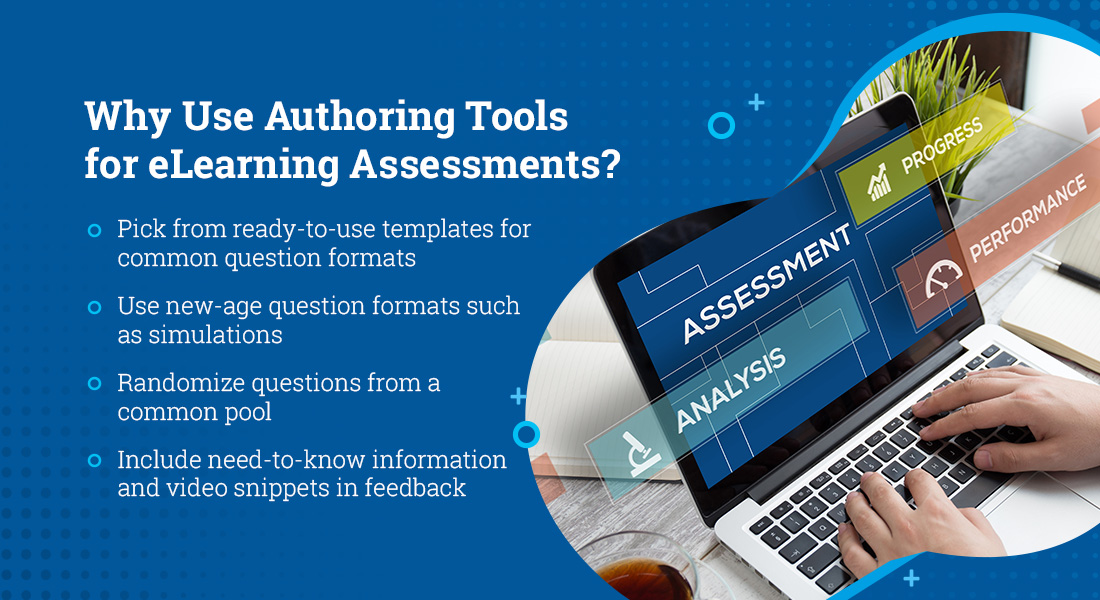How to Leverage Elucidat Templates and Create Engaging Assessments

Asking appropriate questions at regular intervals in between training sessions, can enhance the learners’ retention levels. Evaluations are critical to any type of training, whether it’s online or in the classroom. Any type of training that includes posing questions in between sessions strengthens retention. Assessments also reveal more information about the courses’ efficiency specifically what is functioning well and what needs to be improved.
What are the Different Types of Assessments?
There are many types of Assessments, the most popular formats include:
- Knowledge Checks
- Survey questions
- Final Assessments
Elucidat, a cloud-based publishing tool, provides excellent assessment templates.
Assessments come in a variety of shapes and sizes, but in eLearning, the most popular formats include:
- Knowledge Checks
- Survey questions
- Final Assessments
Let’s look at each one in greater detail to learn more about how they operate:
Knowledge Checks
In most eLearning courses, questions are asked to test the learners’ comprehension after each topic.
During such formative assessment, the right and wrong answers will be revealed as soon as learners select their option. They will get instant feedback and depending on their choice’s questions will be filtered to create the final quiz.
Generating Motivation and Excitement: Ideas to Kill Disengagement in Virtual Training
Surveys
In most cases, there are no right or wrong answers to survey questions Such questions are asked to elicit the learner’s thoughts on a subject.
Assessment
Elucidat’s formative assessment questions are used to create the final quiz. Elucidat’s summative assessment questions do not provide immediate feedback. However, after all the questions in the final quiz have been attempted, the learner will be given their final score.
Elucidat provides over 15 important questions that can be used in your training sessions. A set of question templates is provided below.
Elucidat organizes questions into five categories:

- Choose one answer
- Select multiple answers.
- Sort answers
- Learner input
- Give a rating
A. Choose One Answer

The “Select one answer” section contains a variety of single-choice questions.
- Text Answer Single Choice: This can be used when asking questions when there is only one right answer.
- Text Answer Individual Feedback: This template allows the learner to provide specific feedback based on their selected option.
- Image Answer Single Choice: This template allows the learner to select the right image as well as enter text by enabling the text option.
- Image Answer Individual Feedback: This template is similar to the Text with individual feedback and gives an image option as well.
- Image explorer Single Choice: This template allows you to create questions based on a specific scenario where the learner must choose a particular spot in order to answer correctly.
- Image Explorer Individual Feedback: This template is identical to the Image explorer single choice question, and it also allows the learner to provide feedback for each option.
- Video with Question: This template allows you to play a video and select the right answer to the question presented at the end of the video.
B. Select Multiple Answers
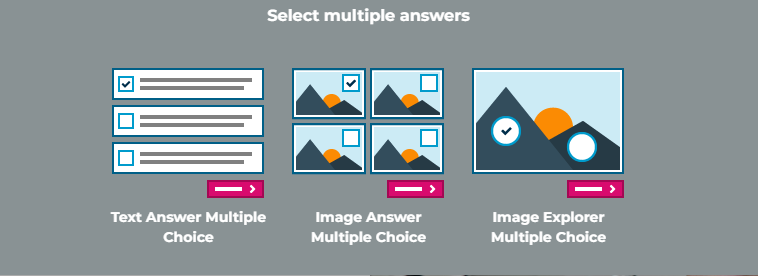
The “Select multiple answers” section contains a variety of multiple-choice questions.
Text answer multiple-choice: This template allows you to create questions with multiple responses, which means the question has more than one right answer.
Image answer multiple-choice: This template allows you to create questions with multiple responses and images.
Image explorer multiple choice: This template allows you to create scenario-based questions where the learner must choose the correct spot in order to get the right answer.
C. Sort Answers

In the “Sort answers” section, Elucidat provides interactive drag and drop templates that serve different purposes.
Drag and Drop: This interactive question template allows you to create questions where the learner drags and drops the right answer. This template offers different view modes for the best fit on mobile devices.
Responsive drag and drop: Compared to the “Drag and Drop” template, the responsive Drag and Drop template occupies less space on the screen and all the items overlap each other to be revealed one by one once they are dropped on top of their respective targets.
Sortable image cards: This template allows you to create images that can be dropped on top of their respective targets.
Answer A or B: This template allows developers to create statements that require true or false responses.
D. Learner Input
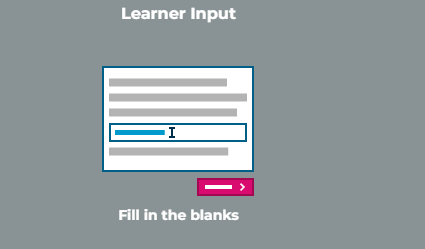
Fill in the blanks: The Learner Input section provides templates with the option to enter text that is ideal to create fill in the blank questions.
E. Give a Rating
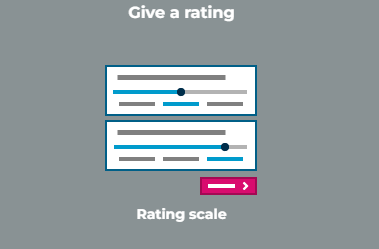
Rating scale: This template comes with a slider bar and by dragging it left or right the learner can choose the correct answer. This template can also be used to rate products and services.
Elucidat offers templates that have been outlined above to help you create interactive and engaging questions. This authoring tool works just as good on mobile devices too.
Conclusion
eLearning assessments are an important aspect of eLearning courses because they help learners assimilate and retain information. When creating eLearning assessments, it’s critical to choose the right questions that would best fulfill the overall learning objectives. To design eLearning assessments, you’ll also need to use the right kind of authoring tool. Elucidat is one such tool that allows you to create assessments that would successfully harness the power of multiple and readily available templates.
Even for the most experienced, creating eLearning exams can sometimes be difficult. However, by following a few best practices, we can create relevant and successful eLearning evaluations. Are you looking to create the training assessments? Learn more about creating eLearning evaluations by attending this mini masterclass on the “basics of designing eLearning assessments”.



